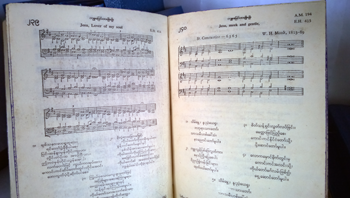ABM Archive Website
THIS WEBSITE CONTAINS ARCHIVE MATERIALS FOR HISTORICAL REFERENCE ONLY
For up-to-date information, including our latest appeals, news, and resources, please visit our current website.
Expect the Unexpected on the Road to Mandalay
It is the first of December and I am driving with Bishop David Nyi Nyi Naing, Bishop of the Anglican Diocese of Mandalay (Church of the Province of Myanmar — CPM), from the Anglican compound in downtown Mandalay city out into the Shan State countryside. We are travelling to see All Saints Anglican Church, up in the mountain town of Pyin Oo Lwin, about an hour and a half away. This was an old fort town during the British colonial period. I can feel the temperature and the humidity dropping. My first surprise is that although we are driving on the right hand side of the road, the Bishop is driving on the right of the car. This is an apparent legacy of a sudden switch from driving on the left to driving on the right, made by a previous government leader. Now almost 90% of cars in Myanmar are Right Hand Drive, but all drive on the right hand side of the road.
In spite of the odd driving configuration, and because of the Bishop’s exemplary driving, we arrive safely in the old hilltop town. We are greeted by the parish rector who shows me over the well-kept All Saints’ Church, built in 1912, during the British colonial period. The Rector shows me a bookshelf containing hymn books ABM’s donors kindly raised funds for a few years ago.
 |
||
| Hymn Book at All Saints Church. © ABM/Julianne Stewart 2014 |
As part of raising money to support the parish, a pre-school operates out of one of the church buildings, where four teachers meet the needs of 40 small children. They were having their morning tea break when I arrived and all looked curious to see a visitor with a camera. Providing pre-school education is a vital contribution the church makes to the development of Myanmar, both as an end in itself, and also as a contributor to primary school completion rates, in a country where such rates are among the lowest in the world. Pre-schools are a good source of income for the church, and the teachers follow a training program provided by the government.
Meeting Interfaith Leaders
After lunch the Bishop drives me to the nearby Buddhist monastery, Asia Light. This is the location of many exciting social programs, especially aimed at young people of the different religions of Myanmar, including Anglican Christians. One of the most exciting programs is Religious Peace. Here I met Sayar Taw, a Buddhist monk in his 50s, who is the driving force behind the monastery’s programs, and a good friend of the Bishop’s. I also met two young Muslim leaders, Zaw Latt and Pwint Phyu who were assisting Sayar Taw with the program for young people. As part of this program young people from different religious backgrounds are taught how to solve conflicts based on the relevant teachings in their own religious traditions. They are also trained to be part of social services such as The Beauty of Sundown program, where they play a part in “healing the loneliness” of elderly people living alone in rented apartments. Another program is the New Life program, focussed on providing counselling and testing to people living with HIV and AIDS. Another, Green Land, aims to assist farmers who have been displaced from their land. Bishop David was very pleased to send his Anglican Youth group there to the youth program last year, and hoped to do so again this year. It was wonderful to see such inter-faith efforts at achieving religious peace and especially the focus on youth, and to know that the Anglican Church is also involved.
 |
||
| From left: Interfaith leaders, Zaw Latt, Bishop David, Sayar Taw and Pwint Phyu. © ABM/Julianne Stewart 2014 |
“You call these projects, but to us they are life.”
Once back in the car, Bishop David tells stories of old community development projects ABM and other donors had supported in the diocese. The Linkho Clean Water Project (a project supported by ABM), still reporting the benefits of having access to clean water four years after completion of the project; and a Planting Project in Namatu (supported by another of CPM’s partners) where the church bought land for a village to grow crops on, and after one year the villagers had made enough from selling the crops to buy the land outright – “You call these projects, but to us they are life”, says Bishop David.
Making our way back to the city of Mandalay there is one more surprise in store. We stop in the township of Myintnge at a Tamil Church, also part of the Anglican Diocese of Mandalay. Here another All Saints’ Anglican Church serves a Tamil congregation. Like many other parishes in the CPM they also run a much-needed pre-school for the local children.
 |
||
| Preschool teachers at the Anglican Tamil congregation of All Saints in Mandalay. © ABM/Julianne Stewart 2014 |
As we drive back into the city of Mandalay under the setting sun, I reflect on what wonderful and unexpected things I have seen. A church which is playing no small part in contributing positively to the dynamic social fabric of modern Myanmar. Tomorrow I will see the Diocesan Learning Centre that ABM is supporting, and meet its new Principal. This Centre is teaching English, as well as some computing, music and Japanese. It is partly an income-generation project and partly a service to the local young people.
I came away feeling that the Church in the Province of Myanmar is a church that is full of energy, dedicated to helping people to flourish, in all the possible meanings of the word.
Julianne Stewart
Programs Director
February 2015
< Back


